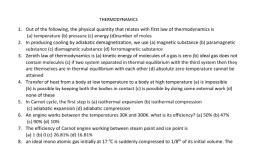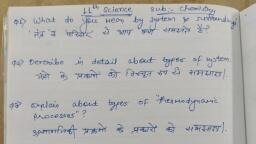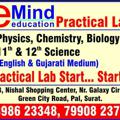Question 1 :
1 mole of an ideal gas at {tex} 25 ^ { \circ } \mathrm { C } {/tex} is subjected to expand reversibly and adiabatically to ten times of its initial volume. Calculate the change in entropy during expansion {tex} \left( \text { in } \mathrm { JK } ^ { - 1 } \mathrm { mol } ^ { - 1 } \right) {/tex}<br>
Question 2 :
In theromodynamics, which one of the following properties is not an intensive property?
Question 3 :
At a particular temperature {tex} \mathrm { H } ^ { + } ( \mathrm { aq } ) + \mathrm { OH } ^ { - } ( \mathrm { aq } ) \longrightarrow \mathrm { H } _ { 2 } \mathrm { O } ( \mathrm { l } ) ; \Delta \mathrm { H } = - 57.1 \mathrm { kJ } . {/tex} The approximate heat evolved when {tex}400 \mathrm { mL } {/tex} of {tex}0.2 \mathrm { M } \, \mathrm { H } _ { 2 } \mathrm { SO } _ { 4 } {/tex} is mixed with {tex}600 \mathrm { mL } {/tex} of {tex}0.1 \mathrm { M } \, \mathrm { KOH } {/tex} solution will be<br>
Question 4 :
A reaction has {tex} \Delta \mathrm H = - 33 \mathrm { kJ } {/tex} and {tex} \Delta \mathrm { S } = - 58 \mathrm { J } / \mathrm { K } {/tex} . This reaction would be
Question 5 :
If CH<sub>3</sub>COOH + OH-<img style='object-fit:contain' src='https://storage.googleapis.com/teachmint/question_assets/JEE%20Main/5e7986a0adb2ea6185a76dcb' height='15' width='20' > CH<sub>3</sub>COO- + H<sub>2</sub>O + q1<br>H+ + OH-<img style='object-fit:contain' src='https://storage.googleapis.com/teachmint/question_assets/JEE%20Main/5e7986a0d3f9ab617fcdbf54' height='15' width='20' > H<sub>2</sub>O + q2<br>then the enthalpy change for the reaction<br>CH<sub>3</sub>COOH <img style='object-fit:contain' src='https://storage.googleapis.com/teachmint/question_assets/JEE%20Main/5e7986a0c6cb6261b35b357a' height='15' width='20' > CH<sub>3</sub>COO- + H+ is equal to
Question 6 :
{tex} \begin{array} { l l } { \text { For the reactions, } } \\ { 2 \mathrm { C } + \mathrm { O } _ { 2 } \rightarrow 2 \mathrm { CO } _ { 2 } ; } & { \Delta \mathrm { H } = - 393 \mathrm { J } } \\ { 2 \mathrm { Zn } + \mathrm { O } _ { 2 } \rightarrow 2 \mathrm { ZnO } ; } & { \Delta \mathrm { H } = - 412 \mathrm { J } } \end{array} {/tex}
Question 7 :
A gaseous system undergoes a change of state from by any of the given path-path-I or path- II as shown in figure<br><img style='object-fit:contain' src='https://storage.googleapis.com/teachmint/question_assets/JEE%20Main/5e79861dd3f9ab617fcdbbfe' height='154' width='185' ><br>As per path -I, Δq = - 400 cal and ΔW = 14 cal<br>As per path -II, Δq = - 48 cal.<br>Therefore work done, ΔW in path -(II) is-
Question 8 :
For the following reaction :<br>CaCO<sub>3</sub> (s) ―→CaO (s) + CO<sub>2</sub> (g)<br>If at 0K, ΔS for the reaction is x cal/mol then entropy of CO<sub>2</sub> (g) at 0K is:
Question 9 :
Heat of neutralisation of a strong acid by a strong base is equal to {tex} \Delta \mathrm { H } {/tex} of
Question 10 :
Read the following statements regarding spontaneity of a process and mark the appropriate choice. <br>(i) When enthalpy factor is absent then randomness factor decides spontaneity of a process.<br>(ii) When randomness factor is absent then enthalpy factor decides spontaneity of a process.<br>(iii) When both the factors take place simultaneously, the magnitude of both of factors decide spontaneity of a process.
Question 11 :
The heat of transition for carbon from the following is <br>C<sub>Diamond</sub> + O<sub>2</sub>(g) ―→ CO<sub>2</sub>(g) ΔH = - 94.3 kcal<br>C<sub>Amorphous</sub>+ O<sub>2</sub>(g) ―→ CO<sub>2</sub>(g) ΔH = - 97.6 kcal
Question 12 :
The {tex} \Delta _ { r } H ^ { \circ } {/tex} for {tex} \mathrm { CO } _ { 2 } ( \mathrm { g } ) + \mathrm { H } _ { 2 } ( \mathrm { g } ) \rightarrow \mathrm { CO } ( \mathrm { g } ) + \mathrm { H } _ { 2 } \mathrm { O } ( \mathrm { g } ) {/tex} is <br>{tex} \Delta H _ { f } \mathrm { CO } _ { 2 } ( \mathrm { g } ) = - 393.5 \mathrm { kJ } \mathrm { mol } ^ { - 1 } {/tex}<br>{tex} \Delta H _ { f } \mathrm { CO } ( \mathrm { g } ) = - 110.5 \mathrm { kJ } \mathrm { mol } ^ { - 1 } {/tex} <br>{tex} \Delta H _ { f } \mathrm { H } _ { 2 } \mathrm { O } ( \mathrm { g } ) = - 241.8 \mathrm { kJ } \mathrm { mol } ^ { - 1 } {/tex}<br>
Question 14 :
A piston filled with 0.04 mol of an ideal gas expands reversibly from 50.0mL at a constants temperature of <img style='object-fit:contain' src='https://storage.googleapis.com/teachmint/question_assets/JEE%20Main/5e79871ed3f9ab617fcdc059' height='16' width='' >. As it does so, it absorbs 208 J of heat. The values of q and w for the process will be :<br><img style='object-fit:contain' src='https://storage.googleapis.com/teachmint/question_assets/JEE%20Main/5e79871fc6cb6261b35b3681' height='25' width='' >
Question 15 :
The heats of neutralisation of four acids {tex} A , B , C , D {/tex} are {tex} - 13.7 , - 9.4 , - 11.2 {/tex} and {tex} - 12.4 {/tex} kcal respectively when they are neutralised by a common base. The acidic character obeys which of the following order?<br>
Question 16 :
A heat engine absorbs heat {tex} Q _ { 1 } {/tex} at temperature {tex} \mathrm { T } _ { 1 } {/tex} and heat {tex} Q _ { 2 } {/tex} at temperature {tex} T _ { 2 } {/tex} . Work done by the engine is {tex} \mathrm { J } \left( Q _ { 1 } + \right. {/tex} {tex} \left. Q _ { 2 } \right) . {/tex} This data
Question 17 :
For the given heat of reaction,<br>(i) {tex} \mathrm { C } ( \mathrm { s } ) + \mathrm { O } _ { 2 } ( \mathrm { g } ) \longrightarrow \mathrm { CO } _ { 2 } ( \mathrm { g } ) + 97 \mathrm { kcal } {/tex}<br> (ii) {tex} \mathrm { CO } _ { 2 } ( \mathrm { g } ) + \mathrm { C } ( \mathrm { s } ) \longrightarrow 2 \mathrm { CO } ( \mathrm { g } ) - 39 \mathrm { kcal } {/tex}<br>The heat of combustion of {tex} \mathrm { CO } ( \mathrm { g } ) {/tex} is
Question 19 :
At absolute zero, the entropy of a pure crystal is zero. This is.
Question 20 :
Which of the following equation represents the value for ΔH<sub>f</sub> of AgI
Question 21 :
There are two samples of same gas initially under similar initial state. Gases of both the samples are expanded. Ist sample using reversible isothermal process and IInd sample using reversible adiabatic process till final pressures of both the samples becomes half of initial pressure. Then :
Question 22 :
In which one of the following sets, all the properties belong to same category (all extensive or all intensive) ?
Question 23 :
Using the following information calculate the heat o formation of {tex} \mathrm { NaOH } {/tex} in {tex} \mathrm { kJ } \mathrm { mol } ^ { - 1 } {/tex} .<br>{tex} 2 \mathrm { Na } ( \mathrm { s } ) + 2 \mathrm { H } _ { 2 } \mathrm { O } ( \mathrm { l } ) \rightarrow 2 \mathrm { NaOH } ( \mathrm { s } ) + \mathrm { H } _ { 2 } ( \mathrm { g } ) {/tex} <br>{tex} \Delta \mathrm H ^ { \circ } = - 281.9 \mathrm { kJ } {/tex}<br> {tex} \Delta \mathrm H _ { f } ^ { \circ } \mathrm { H } _ { 2 } \mathrm { O } ( \mathrm { l } ) = - 285.8 \mathrm { kJ } / \mathrm { mole } {/tex}<br>
Question 24 :
Match the enteries of column I with appropriate entries of column II and choose the correct option out of the four options<br><table><tr><td>Column I</td><td>Column II</td></tr><tr><td>(X) Isothermal</td><td>(p) {tex}\Delta{/tex}T = 0</td></tr><tr><td>(Y) Isobaric</td><td>(q){tex}\Delta{/tex}V = 0</td></tr><tr><td>(Z) Adiabatic</td><td>(r) {tex}\Delta{/tex}P = 0</td></tr><tr><td>(W) Isochoric</td><td>(s) q = 0</td></tr>
Question 25 :
Equal volumes of molar hydrochloric acid and sulphuric acid are neutralized by dil. NaOH solution and x kcal and y kcal of heat are liberated respectively. Which of the following is true ?





























